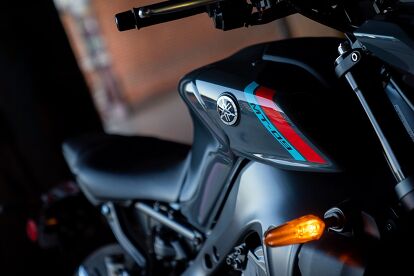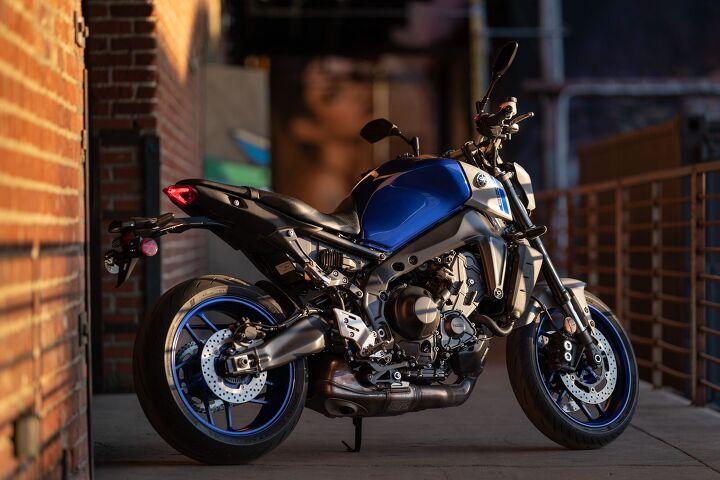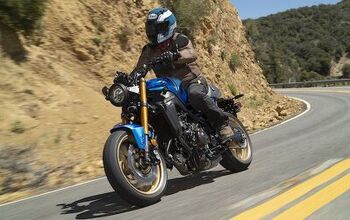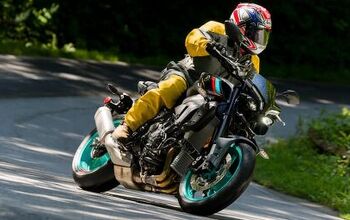2021 Yamaha MT-09 Review - First Ride
Is the Third Gen the Charm?
MT-07, and its spunky 689 twin-cylinder motor, has always been a crowd favorite at MO. MT-10 was an immediate hit with its crazy crossplane 999 cc R1 motor… MT-03 is fine for getting your feet wet… but MT- (nee FZ)-09 has never seemed to quite exactly hit the mark, even though it was close enough to win MO’s coveted Best Value award in 2015.
2021 Yamaha MT-09
| Engine | 18.5/20 |
| Suspension/Handling | 13.0/15 |
| Transmission/Clutch | 9.5/10 |
| Brakes | 8.0/10 |
| Instruments/Controls | 4.0/5 |
| Ergonomics/Comfort | 9.5/10 |
| Appearance/Quality | 8.5/10 |
| Desirability | 9.0/10 |
| Value | 9.5/10 |
| Overall Score | 89.5/100 |
Actually, value is still a big deal with this bike, Yamaha says. The other two sacred pillars are torque and agility. Value-wise, the bottom line has crept up $400 to $9,399, but that’s not bad for a 90%-redesigned Yamaha (though for reasons we’ll get to later, it’s going to be more like $11k). As for torque, the retuned-for-Euro 5 Triple goes from 847 to 890 cc, gaining 6% more twisting force in the process.
2021 Yamaha MT-09 Getting Larger Engine To Meet Euro 5 Standards
Yamaha USA’s not saying, but Yamaha UK’s website has it at 68.6 lb-ft at 7000 rpm and 117.4 horsepower at 10,000 rpm. That’s slightly less than a nice Kawasaki Z900 four-banger or KTM 890 Duke, but definitely in the ballpark.
Agility-wise, the new MT weighs just 417 pounds, says Yamaha, which is a whopping 51 fewer than a 468-lb Z900 – and 57 less than the 474-lb BMW F900R. Then there’s that other 890 cc elephant in the room, our 2020 Motorcycle of the Year. KTM’s Duke 890 R tipped our scales at 408, wet (when it beat up the 416-lb Triumph Street Triple RS in this comparo last June). Lightness is expensive; both those bikes are quite a bit more money than the Yamaha. Heck, Yamaha says the MT-09 is only 11 pounds heavier than MT-07.
FRAMED!
Along with that light weight and power, an all-new frame continues the agility theme, adds stability at speed – and to my orbs at least, makes the new bike way easier to gaze upon than the outgoing model. Yamaha have been masters of “Controlled Fill” vacuum die-casting since they first rolled out that technology 15 or so years ago, and sometimes it looked like the engineers were casting complex pieces more to impress each other than to look good on a motorcycle. But the new frame that ties the MT’s headstock to its (new) swingarm is a really graceful work of engineering art. Yamaha says the frame is but 1.7mm thick at its thinnest point, and designed for 50% more lateral stiffness as well as greater strength torsionally and longitudinally.
The subframe is also aluminum now instead of steel, which reduces weight by 3.3 lbs. Lowering the steering stem 30mm slightly sharpens the MT’s angle of attack, but Yamaha says trail has actually increased 0.2-inch to 4.3, while rake remains the same 25 degrees as before.
Fitting End
It’s been a few years since I’ve ridden an MT-09, but I don’t remember the old one fitting my bod as well as the new one; it seems like the new frame is narrower between your legs, and the new gas tank shape reinforces the feeling of being in a skinny but comfortable cockpit. Meanwhile, the seat’s broad and thick enough to the rear where you actually sit.
To make the bike fit more people, the handlebars and footpegs can be adjusted to two different positions; handlebar clamps can be rotated 10mm forward, and the footpeg mounts can be raised 14mm higher and 4mm rearward.
For 5’8” me, these are just about perfect ergonomics for a naked sportbike. The 32.5-inch tall saddle is just right and the classic all levers and controls fall readily to hand cliche fits. Taken together with the torquey powerband and lightness, this is about as good as it gets for squirting around in the urban maze. Heck, man, you even get a quickshifter, that does really good work both up- and downshifting. Rolling at 80 mph and 5000 rpm, things remain copacetic and comfortable.
CP3 Gen 3
Fuelling was an issue for the first few years of the FZ-09’s life, with Yamaha applying various Band-aids in an attempt to get it right. By 2019 (second year of MT), they definitely had it down, as the XSR900 – also CP3 powered – was good enough to win our comparison against the Indian FTR1200 and Ducati Monster 1200 that year.
Ducati Monster 1200S, Indian FTR1200 And 1200S Shootout At The Yamaha XSR900 Corral
“Yamaha Chip-controlled Throttle” is a phrase they’ve been throwing around forever, too. But this one’s different: Unlike the system on former models that uses a cable to relay throttle inputs via a pulley, the 2021 MT-09 gets a new “Accelerator Position Sensor Grip” ride-by- wire unit that shaves a little weight while providing excellent throttle feel. With the APSG, says Yamaha, degree of throttle opening is detected by a sensor and magnet, which send signals to the throttle valve motor. “For good operational feel, the APSG is comprised of a spring, slider and gear and produces varying degrees of friction (resistance) to recreate a natural throttle feel during use. The construction of the APSG for the 2021 MT-09 is the same as the one on the 2020 YZF-R1/R1M but has model-specific settings for the degree of friction and throttle opening.”
For me, it’s easier to just observe that “carburetion is spot-on,” like we used to do in the old days. Picking up the throttle from low rpm in slow corners is never not smooth, or when rolling it back open from any rpm, and the 6%-torquier, 43 cc-bigger Triple pulls hard toward 10,000 rpm with an even spine-tinglier howl thanks to an airbox re-jiggered for just that effect. Not that you usually rev it out all that far on the road. The fact that first and second gears are a bit taller than before (1st gear goes from 2.666 to 2.571; 2nd from 2.000 to 1.947), and the crankshaft is a bit heavier, probably also helps with smooth power delivery.
Inside that engine, virtually every major component is new, including the pistons, connecting rods, camshafts, and crankcases. Stroke is 3mm longer than before, but connecting rods are 1.5mm shorter, which made keeping the same engine height possible. Compression ratio stays at 11.5:1. Now we’re Euro 5 compliant, and Yamaha says we’re even 11% more fuel efficient – up to 49 mpg. Which could come in handy since fuel capacity is only 3.7 gallons.
Sport Mode
You get the usual modes, but they’re not labelled typically Sport, Road or Rain, as you wouldn’t want the consumer to grow complacent.
TCS is, you guessed it, traction control. SCS is Slide Control System (MotoGP-derived says Yamaha), and LIF is lift, or wheelie control; 1 is less intervention, 2 is a bit more, Off is ahhhh, off. These functions are all informed by the MT-09’s first IMU, which is the same one as the 2020 R1’s but now 30% smaller.
Independently of that, there are four “D-modes” for tailoring throttle response: Mode 1 gives the sharpest response, Mode 2 is slightly more mellow… mode 4 is the most tame throttle map, and the engine doesn’t get to full power in it. Rain mode is what every other manufacturer calls it.
Finally, there are two BC, or brake modes, also R1-derived: BC1 gives you fixed ABS sensitivity. Mode BC2 has “ABS sensitivity increasing with bank angle and slip rate data from the IMU,” ie., lean-sensitive. Dunno why you wouldn’t just leave it in BC2 all the time, but there’s a lot to love here in a $9,400 motorcycle.
For chasing our merry band of motojournalists and a couple of Yamaha test pilots around some nice SoCal canyons on a dry day with temps in the 60s, it was mode 1 all the way and BC2, and dang the torpedoes, full speed ahead.
Once your Bridgestone Battlax S22s on their light new wheels are up to temperature, and even before that, the MT encourages spirited riding. Great ergonomics, big torque, and light weight. The new bike’s chassis feels lively but not loose, and feeds back really good road feel – just like that last XSR900 did, and a bit more. It’s fun to brake deep into corners, feeling the edges of the tires, and smoothly blend throttle back in with zero lags or hiccups.
The new bike has serious horsepower, too, and the excellent up/down quickshifter makes it easy and fun to use all of it, as you attempt to keep up with the pack while deciding if downshifting for the corners or concentrating on roll speed is faster? Screw it, downshifting is more fun, thanks to the quickshifter, and I take back what I said about seldom revving the Triple to redline as group dynamics take hold after lunch on Sand Canyon…
Suspenseful
We’re using the same basic 41mm KYB inverted front fork from before, “with new settings to match the character of the new compact frame for a smoother, more controlled ride. These settings slightly reduce movement in the pitch direction but make it easier for the rider to feel the suspension working while riding.” Our Yamaha rep is currently working on what that means exactly. Front and rear suspension are adjustable for spring preload and rebound damping; the fork is also adjustable for compression damping.
Again, the XSR900 we tested two years ago had great suspension, better than the last MT-09 we rode – and these new MT units feel a lot like the XSR ones, perfectly capable for everything up to and including aggressive sport riding, even if they don’t have quite the plushness or control of some more expensive motorcycles over the bumps in a straight line. Accelerating WFO over bumps and expecting maybe a little headshake, the MT forges serenely ahead. On its side, it feels like that cool new frame is also absorbing bumps; its front engine mounts hang from the same kind of long “ears” as Yamaha’s MotoGP bike. They actually made the outer fork tube sections between the triple clamps thinner, to further “tune” the chassis. Crazy.
Anyway, it’s a superfun, low-stress bike to fling around in the canyons: Powerful but not too powerful, light and comfortable, confidence-inspiring, highly tractable. Your KTM Scalpel (ie, 890 Duke) might have a few more horses and more sophisticated suspension, but I bet there wouldn’t be much in it between the two.
But where’s the cruise control button?
It’s on the MT-09 SP, fool. Other choice morsels on the SP include an upscale gold-tubed 41mm KYB fork adjustable for preload, rebound, and high- and low-speed compression – with Diamond Like Carbon (DLC)-coated sliders. Out back resides the holy of holies, a fully adjustable Öhlins shock with remote reservoir and preload adjuster. Yamaha says it provides stronger damping force compared to the base model while providing good comfort, and improved bump absorption “with less stroke feeling.”
I was a bit miffed at Yamaha when they said the SP was going to be in the $12,000 range, because it would be BS! to charge people $2600 for cruise control! But maybe I misheard, because the SP has now appeared on the US website, and it’s bearing a $10,999 price tag. I guess that’s not so bad. Sadly, there were no SPs on hand for us to sample on our ride day last week, but $11k seems like a smoking deal for all the things the SP’s got going on – especially if that suspension is as good as it looks on paper.
Heck, $9400 isn’t bad for the base model either, complete with quickshifter, IMU-based electronics, full LED lighting including new turn signals… but yours truly would definitely need the SP and the cc button for $1600 more.
Naked 900s (or whatever this class is called now) is a vicious battleground, but it feels like Yamaha’s finally done right by its most excellent CP3 Triple, and by the motorcycling masses for keeping it cheap. Ish. Bring on the Scalpel, Euroweenies! Let’s rumble.
2021 Yamaha MT-09
+ Highs
- Third gen’s the charm?
- Mucho moto for $9,399
- Dunno about you but I’ll need the SP
– Sighs
- Cruise should be a stand-alone $300 accessory
- Good brakes, but not great brakes…
- 3.7-gallon tank could be bigger
In Gear

Helmet: [url=https://imp.i104546.net/c/404739/782962/11256?u=https%3A%2F%2Fwww.revzilla.com%2Fmotorcycle-riding-gear-ca&subid1=VS_motorcycle_Revzilla_yamahamt09firstride]Shoei Neotec 2 Splicer[/url][/b] $799[/p]
- Jacket: [url=https://vansonleathers.com/mens-collection-of-motorcycle-jackets-racing-suits-pants-chaps-more/39-model-AR-rayon-firenze-leather-motorcycle-jacket-AR2.html]Vanson AR3[/url] $562.50[/b]
- Gloves: [/b] [url=https://imp.i104546.net/c/404739/782962/11256?u=https%3A%2F%2Fwww.revzilla.com%2Fmotorcycle%2Freax-superfly-mesh-gloves&subid1=VS_motorcycle_Revzilla_yamahamt09firstride]Reax Superfly Mesh[/b][/url] $69
- Jeans: [url=https://www.motonation.com/store/pc/viewPrd.asp?idproduct=7828&idcategory=196]Trilobite Parado Elastic Men’s Jeans[/url][/b] $219
Boots: [url=https://www.motonation.com/store/pc/viewPrd.asp?idproduct=5944&idcategory=6]Sidi Arcadia Tex[/url][/b] $179[/b][/p]
2021 Yamaha MT-09 Specifications | |
|---|---|
| MSRP | $9,399 |
| Engine Type | 890cc liquid-cooled inline-three cylinder, DOHC, four valves per cylinder |
| Bore and Stroke | 78.0mm x 62.1mm |
| Compression Ratio | 11.5:1 |
| Horsepower | 117.4 horsepower at 10,000 (Yamaha UK claimed, crankshaft) |
| Torque | 68.6 lb-ft at 7000 rpm (Yamaha UK claimed, crankshaft) |
| Transmission | 6-speed; slip-assist clutch; up/down quickshifter |
| Final Drive | Chain |
| Front Suspension | 41mm inverted KYB fork; adjustable for spring preload, rebound damping, compression damping, 5.1-inch travel |
| Rear Suspension | Single shock; adjustable for spring preload and rebound damping, 4.8-in travel |
| Front Brake | Two 298mm discs, radial-mount four-piston calipers, lean-sensitive ABS |
| Rear Brake | 245mm disc, lean-sensitive ABS |
| Front Tire | 120/70-R17 |
| Rear Tire | 180/55-R17 |
| Rake/Trail | 25 deg/4.3 in. |
| Wheelbase | 56.3 in. |
| Seat Height | 32.5 in. |
| Curb Weight (Claimed) | 417 lbs. |
| Fuel Capacity | 3.7 gal. |
| Colors | Storm Fluo; Matte Raven Black; Team Yamaha Blue |
| Warranty | One year limited warranty |
More by John Burns























































































Comments
Join the conversation
Yes to the performance, price and weight but a big no to the styling.
Given the triviality of adding the buttons for it (it would probably cheaper to make them all with the same control pod), even cruise control being an option is kinda BS. Only making it available on the more expensive model is especially BS. But we've seen this before with Yamaha, with the FJ09/Tracer. I can understand why they do it, but I don't have to like it.
Probably wouldn't be a deal breaker for me personally, as I'm unlike to go touring on an MT-09, but still...